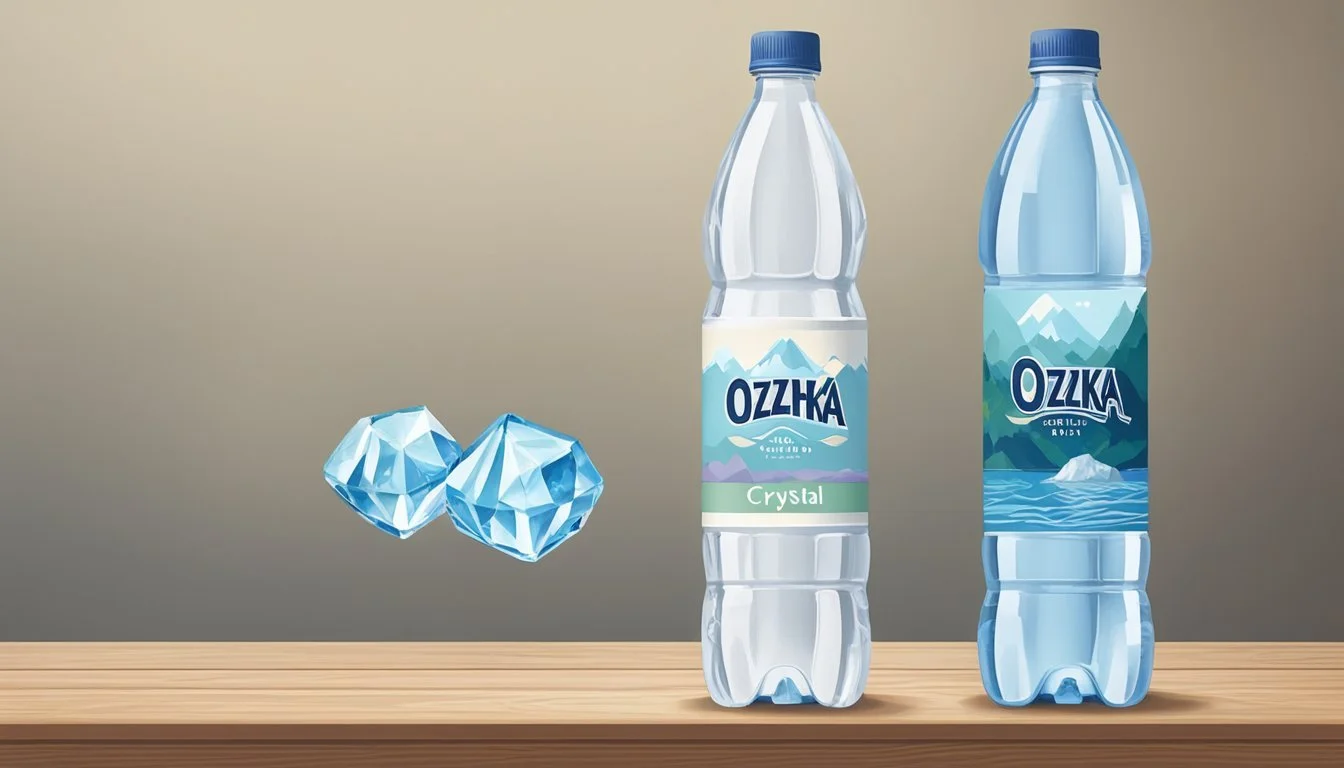Ozarka vs. Crystal Lake
Which Bottled Water is Better?
When it comes to selecting bottled water, both Ozarka and Crystal Lake have their unique characteristics. Ozarka sources its water locally from Texas, ensuring a fresh and consistent taste that many people prefer. Crystal Lake, on the other hand, emphasizes purity, often promoting its rigorous filtration processes that aim to deliver clean and crisp water.
The debate over which brand is superior often hinges on individual preferences. Those who appreciate a local touch might gravitate towards Ozarka for its regional sourcing. Meanwhile, fans of Crystal Lake trust its dedication to stringent purification standards, making it a go-to for people who prioritize purity in their bottled water.
In deciding between Ozarka and Crystal Lake, consider what matters most to you—whether it's the local sourcing of Ozarka or the assured purity of Crystal Lake. Both brands offer reliable hydration but cater to slightly different tastes and priorities.
History and Origin of Ozarka and Crystal Lake
Ozarka and Crystal Lake have storied histories in the bottled water industry, each originating from distinct regions. Ozarka traces its roots back to the mineral springs of Eureka Springs, Arkansas, while Crystal Lake has established its heritage in pure, natural sources across the United States.
Ozarka Brand Evolution
Ozarka's history dates back to 1905 when it began bottling water from the Ozark Mountains. Originally, the site known as Basin Spring was considered sacred by Native American tribes who valued its healing properties. The official Ozarka Spring Water Company was established in Eureka Springs, Arkansas.
By the Victorian era, Eureka Springs had become a health resort, attracting visitors for its pure mineral springs. In the late 20th century, the brand underwent significant changes, including a move by a California bottler, which shifted the bottling operations out of state. Despite these changes, Ozarka maintained its reputation for quality and connection to its origins in Arkansas.
Crystal Lake: The Journey
Crystal Lake emerged as a prominent bottled water brand in the mid-20th century, sourced from pristine natural springs in various locations across the United States. The brand prides itself on delivering clean, refreshing water with high standards of purity.
Initially, Crystal Lake focused on regional distribution, leveraging local sources to maintain freshness and quality. Over time, the brand expanded its reach, catering to a broader audience. Crystal Lake's commitment to sustainability and eco-friendly packaging has also played a significant role in its journey, appealing to environmentally conscious consumers.
By staying true to its roots while embracing modern practices, Crystal Lake has carved a niche in the competitive bottled water market.
Sourcing and Water Source Comparison
Ozarka and Crystal Lake offer distinct approaches to how they source their water, each with unique considerations that are important for consumers. Here’s an in-depth look at the sourcing methods employed by both brands.
Ozarka Sourcing Methods
Ozarka prides itself on sourcing natural spring water from wells located in the state of Texas. This local focus helps ensure a fresh supply, drawing from the state's rich groundwater reserves.
The company’s water undergoes rigorous testing to meet safety and quality standards. By sourcing from regional springs, Ozarka supports local water ecosystems and communities. Their approach results in slightly premium pricing due to the emphasis on local, natural sources.
Crystal Lake Sourcing Techniques
Crystal Lake draws its water from multiple natural springs primarily situated in the Sierra Nevada region. This strategic selection of pure sources guarantees high-quality spring water.
To maintain the integrity of the water, Crystal Lake adopts meticulous filtration and purification processes. This brand emphasizes minimal processing to preserve the natural mineral content and taste. These techniques underscore Crystal Lake's commitment to providing a clean, refreshing product directly from some of the most pristine spring sources.
Purity and Quality
When comparing Ozarka and Crystal Lake bottled water, examining purity standards and quality assessments is essential. This analysis highlights key aspects of filtration processes, regulatory compliance, and overall safety measures.
Ozarka Purity Standards
Ozarka prides itself on its rigorous purity standards. The water undergoes a multi-step filtration process to remove impurities, ensuring it meets the EPA and FDA regulations. The process involves several stages, including carbon filtration and reverse osmosis, which help eliminate heavy metals such as lead and arsenic.
Quality reports, often available in PDF format on their website, regularly confirm the absence of harmful contaminants. These reports detail the levels of various substances, demonstrating Ozarka’s commitment to providing safe and clean drinking water. Their adherence to stringent standards reassures consumers of the water’s purity.
Crystal Lake Quality Assessments
Crystal Lake bottled water is also subjected to thorough quality assessments. Their process includes an advanced filtration system designed to remove a broad spectrum of contaminants. They conduct regular tests to ensure compliance with both EPA and FDA regulations, offering a high level of assurance regarding the water's safety.
Quality assessment reports, accessible in PDF format from their website, offer transparency about the water's composition. These documents show a consistent record of low levels of heavy metals, such as lead and arsenic, emphasizing Crystal Lake’s dedication to maintaining high quality standards. This accessible information helps consumers make informed choices about their drinking water.
Taste Profile Analysis
Ozarka and Crystal Lake present distinct taste profiles, influenced by their unique sources and mineral content. This section breaks down these differences, focusing on what consumers can expect in terms of taste, aftertaste, and overall flavor experience.
Ozarka Taste Factors
Ozarka prides itself on its natural spring water origins, sourced from springs in Texas. This gives it a refreshing taste marked by natural minerals that contribute to its crisp, clean profile.
Consumers often describe the water as having a subtle, earthy flavor, which is attributed to the minerals present in the water. The presence of these minerals, including calcium and magnesium, enhances the overall water taste without overpowering the palate.
The aftertaste of Ozarka is generally mild, with no significant lingering bitterness. This clean finish makes it appealing for regular consumption, particularly for those who appreciate a natural, unaltered water taste.
Crystal Lake Flavor Characteristics
Crystal Lake, unlike Ozarka, often presents a different taste profile due to its specific source and processing methods. This brand is known for its purified water with added electrolytes for taste, which can make the flavor slightly more manufactured but still appealing.
The water's flavor is commonly described as crisp and clean, with a more pronounced electrolytic content. The added electrolytes, such as potassium and sodium, aim to enhance the water's taste, providing a slight saltiness that some consumers find refreshing.
In terms of aftertaste, Crystal Lake offers a smooth finish with a barely noticeable trace of the added minerals. This makes it a good choice for those seeking a consistently clean and straightforward water taste.
Health and Safety Evaluations
Both Ozarka and Crystal Lake are scrutinized for their health impacts and safety protocols. Evaluations focus on bottle materials, contaminants, and adherence to consumer safety standards.
Ozarka Health Impacts
Ozarka sources its water locally from Texas, ensuring that it goes through rigorous testing before reaching consumers. The water has a smooth taste and maintains a balanced pH level, which is important for health.
Ozarka uses BPA-free bottles, which reduces potential hormone-disrupting chemical exposure. Despite these advantages, some concerns have been raised about the transparency of their testing processes. Reports indicate that detailed contamination data is not always readily available, which may concern consumers who prioritize full disclosure.
Key Points:
Local Texas sourcing
Rigorous testing
BPA-free bottles
Concerns about data transparency
Crystal Lake Safety Protocols
Crystal Lake bottled water adheres to stringent safety protocols to ensure consumer health. Their water undergoes multiple filtration stages to remove contaminants, including potential PFAS chemicals that can pose long-term health risks.
To maintain safety, Crystal Lake utilizes high-quality control standards and comprehensive safety checks. Unlike some competitors, they provide detailed consumer reports, including specifics on water source and filtration methods. Additionally, the plastic bottles used are certified BPA-free, aligning with industry best practices for safe packaging.
Key Points:
Advanced filtration stages
Detailed consumer reports
High-quality control standards
BPA-free bottles
Environmental Impact and Sustainability
Both Ozarka and Crystal Lake prioritize eco-friendly practices and sustainability to address concerns related to plastic bottles and environmental preservation.
Ozarka Environmental Initiatives
Ozarka focuses on reducing plastic waste by incorporating recycled materials in their bottles. They claim that a significant percentage of their packaging uses recycled plastic, minimizing the environmental footprint.
Their production processes emphasize water conservation and energy efficiency. They strive to lower their carbon output through optimized logistics and distribution channels. Ozarka’s bottling plants are designed to be energy-efficient, incorporating renewable energy sources such as solar panels where possible to further decrease reliance on traditional energy.
Ozarka also supports local water replenishment projects to maintain the natural water cycles in regions they source from. These projects help sustain local ecosystems and ensure a reliable supply of clean water for future generations.
Crystal Lake's Sustainable Practices
Crystal Lake prides itself on advanced water disinfection processes that ensure high-quality drinking water without excessive waste. Unlike many competitors, they use eco-friendly disinfection methods that reduce chemical usage.
Their packaging line emphasizes sustainability, utilizing primarily biodegradable and compostable materials. Crystal Lake aims for zero waste throughout its production process by efficiently using resources and recycling waste products wherever feasible.
Furthermore, Crystal Lake is actively involved in community-based environmental projects, such as tree planting and waterway cleanups. These engagements not only improve the environment but also foster community awareness about sustainability issues. Crystal Lake’s commitment to continuous improvement keeps them at the forefront of sustainable practices in the bottled water industry.
Brand Presence and Consumer Sentiment
Ozarka and Crystal Lake have established themselves in the bottled water market in distinct ways. Their brand influence and public perception play crucial roles in consumer choice.
Ozarka's Market Influence
Ozarka sources its water locally from Texas, giving it a strong regional presence. This local sourcing has garnered the brand a loyal following within the state.
They emphasize natural spring water, which appeals to consumers looking for authenticity. Ozarka's marketing strategies, through email campaigns, Twitter, and YouTube, highlight their commitment to quality. Additionally, their partnership with retailers ensures good visibility in stores.
Consumer sentiment around Ozarka is generally positive. Many appreciate its fresh taste and reliable quality. They have a solid presence on social media, where positive reviews and recommendations boost their market demand.
Crystal Lake Brand Perception
Crystal Lake is regarded for its crisp and clean taste. It has built a niche audience that values purity and minimal processing. The brand's active engagement on social media and frequent email updates keep consumers informed about new product offerings.
While not as widely known as Ozarka, Crystal Lake has a dedicated customer base. Reviews online often commend its taste and environmental efforts. Their YouTube channel features educational content about water purity, further solidifying consumer trust.
In regions where available, Crystal Lake's demand is consistent. They focus on ensuring product availability and maintaining quality. This dedication to consumer satisfaction helps maintain a positive brand image.
Comparative Analysis of Ozarka and Crystal Lake
To determine the better bottled water between Ozarka and Crystal Lake, key factors such as mineral content, additives, market position, and competition will be explored.
Comparing Mineral Content and Additives
Ozarka sources its water from natural springs in Texas, which affects its mineral profile. It typically contains calcium, magnesium, and sodium, contributing to its refreshing taste.
Crystal Lake, a lesser-known brand, also boasts natural spring sources but has a slightly different mineral composition. It often features higher levels of magnesium and potassium, which some consumers might prefer for their health benefits.
Additives: Ozarka may include minimal additives, focusing on purity. Crystal Lake emphasizes no artificial additives, attracting a more health-conscious demographic.
Market Position and Competing Brands
Ozarka positions itself as a trusted regional brand with strong ties to its local Texas roots. Priced reasonably and often sold in bulk, it competes primarily in the mid-range market alongside brands like Nestlé Pure Life and Dasani.
Crystal Lake, with its unique mineral profile, targets a niche market, appealing to those looking for natural, high-mineral content water. It competes with premium brands like Fiji Water, Evian, and Voss, though it remains less well-known.
Despite its lower market recognition, Crystal Lake's focus on purity and specific mineral benefits provides a strong argument for its quality.
Final Verdict
The comparison between Ozarka and Crystal Lake bottled waters considers taste, sourcing, and cost.
Taste:
Ozarka offers a clean, refreshing taste, often praised for its local Texas source.
Crystal Lake has a smoother profile, which some people might prefer.
Sourcing:
Ozarka sources water primarily from Texas' springs, giving it a local, natural appeal.
Crystal Lake, while not widely publicized about specific sources, maintains high-quality standards.
Cost:
Ozarka is more regionally priced, with variations depending on location.
Crystal Lake tends to be consistent in pricing but may come at a slightly higher cost due to its branding and packaging.
Quality:
Both brands meet the International Bottled Water Association's standards, ensuring safety and quality.
Packaging:
Ozarka often comes in larger packs, offering convenience for bulk purchases.
Crystal Lake usually focuses on premium packaging, sometimes in glass bottles for added quality.
Ozarka and Crystal Lake offer reliable and refreshing options for bottled water enthusiasts. Preferences may vary based on regional availability, taste profiles, and specific needs.
More About Ozarka
Mountain Valley Spring Water vs Ozarka: Which Bottled Water is Better?
Ozarka vs Kirkland Signature: Which Bottled Water is Better?
Ozarka vs Richard's Rainwater: Which Bottled Water is Better?
Ozarka vs Whole Foods Italian Still Mineral water: Which Bottled Water is Better?
More About Crystal Lake
Aqua Carpatica vs Crystal Lake: Which Bottled Water is Better?
Cascade Mountain vs Crystal Lake: Which Bottled Water is Better?
Core Hydration vs Crystal Lake: Which Bottled Water is Better?
Crystal Geyser vs Crystal Lake: Which Bottled Water is Better?
Crystal Lake vs Essence pH10: Which Bottled Water is Better?
Crystal Lake vs Proud Source: Which Bottled Water is Better?
Hawaii Volcanic vs Crystal Lake: Which Bottled Water is Better?
Hawaiian Springs vs Crystal Lake: Which Bottled Water is Better?
Ice Mountain vs Crystal Lake: Which Bottled Water is Better?
Icelandic Glacial vs Crystal Lake: Which Bottled Water is Better?
Kirkland Signature vs Crystal Lake: Which Bottled Water is Better?
Liquid Death vs Crystal Lake: Which Bottled Water is Better?
Mountain Valley Spring Water vs Crystal Lake: Which Bottled Water is Better?
Nestle Pure Life vs Crystal Lake: Which Bottled Water is Better?
Poland Spring vs Crystal Lake: Which Bottled Water is Better?
Purely Sedona vs Crystal Lake: Which Bottled Water is Better?
Richard's Rainwater vs Crystal Lake: Which Bottled Water is Better?
San Pellegrino vs Crystal Lake: Which Bottled Water is Better?
Simple Truth vs Crystal Lake: Which Bottled Water is Better?
Solan de Cabras vs Crystal Lake: Which Bottled Water is Better?
Talking Rain AQA vs Crystal Lake: Which Bottled Water is Better?
Whole Foods 365 vs Crystal Lake: Which Bottled Water is Better?
Whole Foods Italian Still Mineral water vs Crystal Lake: Which Bottled Water is Better?







